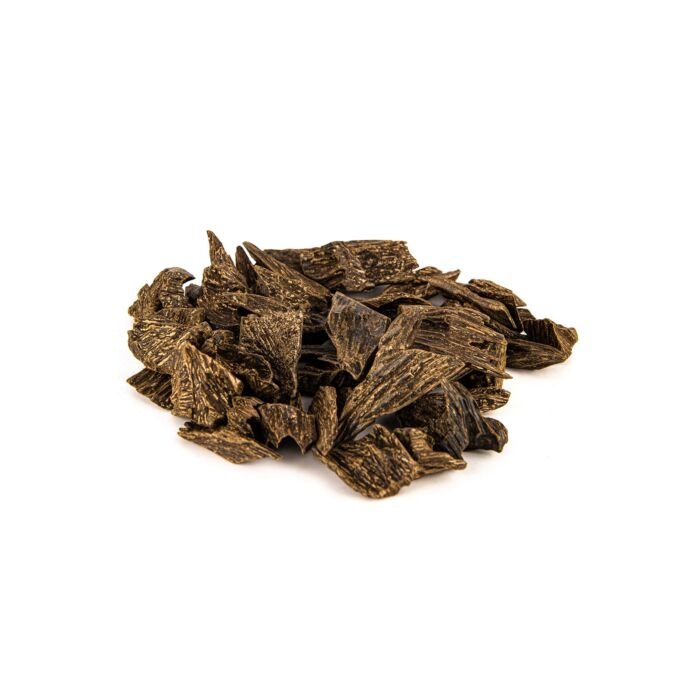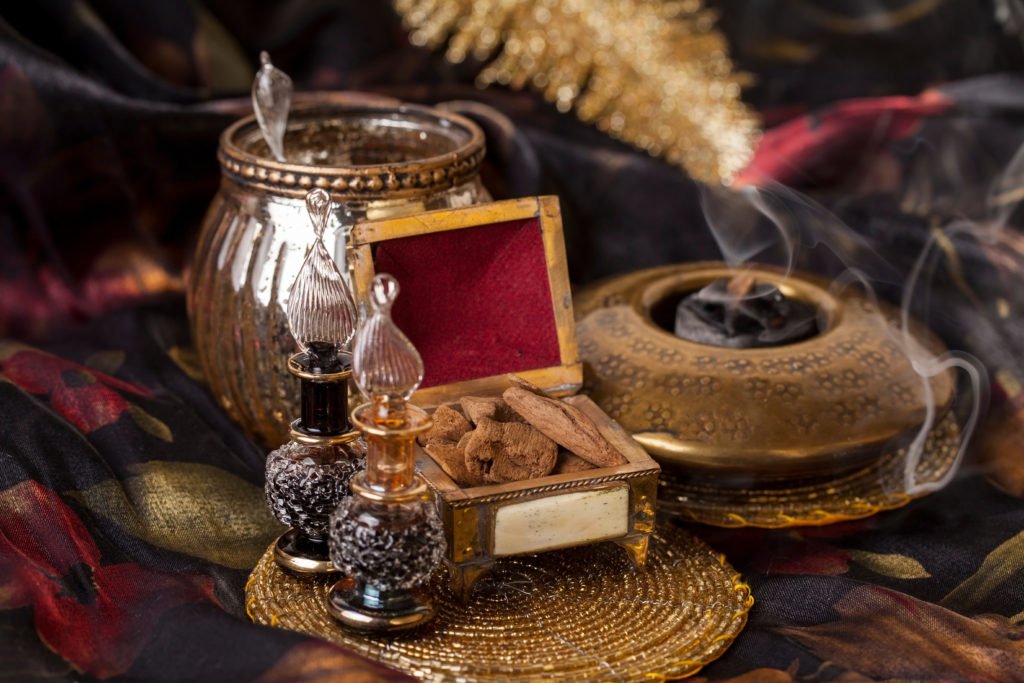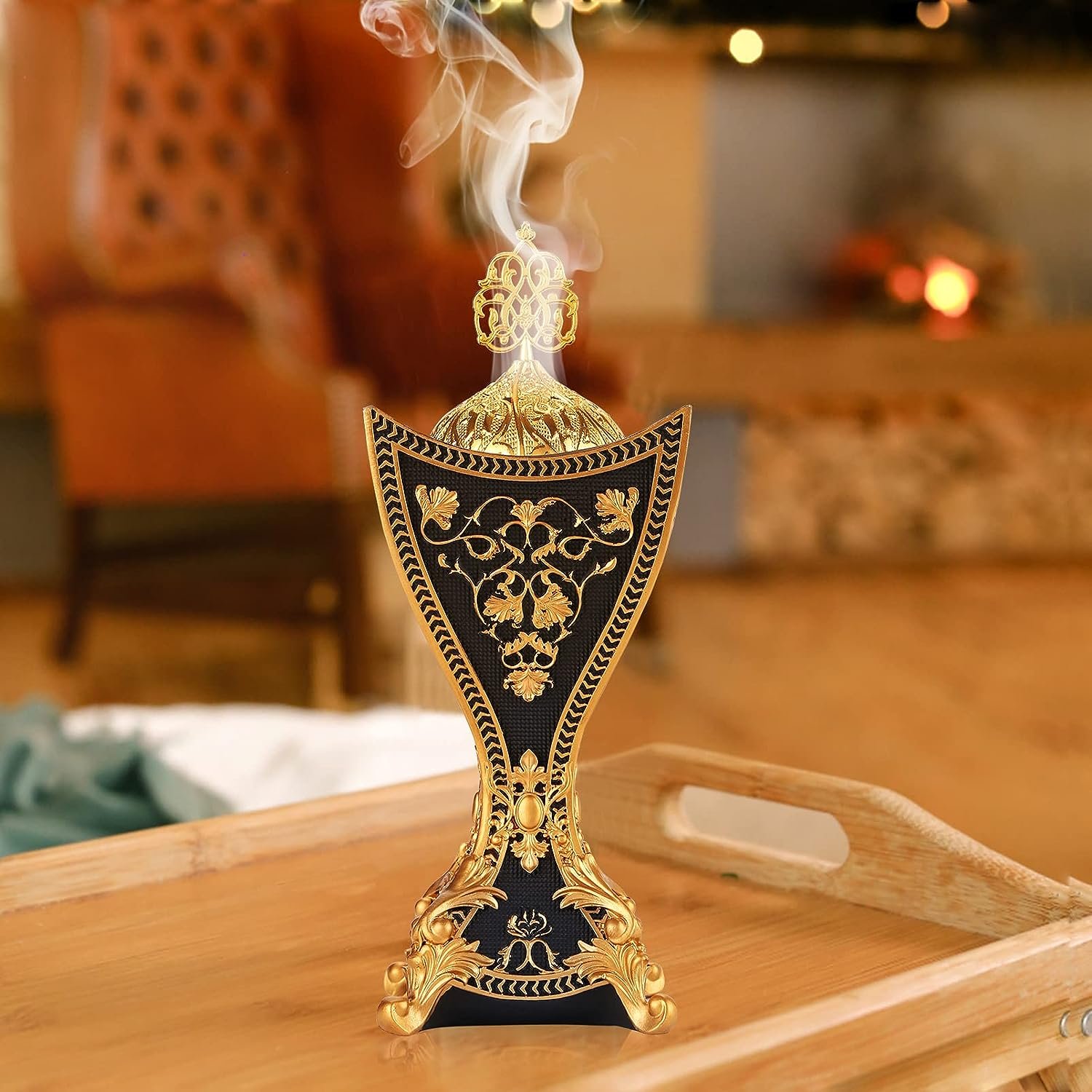Introduction
Welcome to a sensory exploration like no other as we delve into the question, “What is Bakhoor?” This exceptional form of incense hails from the culturally rich landscapes of the Middle East and Southeast Asia and is a luxurious blend of agarwood chips infused with aromatic oils. Far from being just another incense, Bakhoor has transcended its original sacred uses to become a global phenomenon in modern living spaces. Whether you’re passionate about home fragrances, intrigued by spirituality and wellness, or fascinated by diverse cultural traditions, this blog post is your all-inclusive guide to one of mankind’s most treasured aromatic experiences. So ignite your Bakhoor burner and prepare to embark on an unparalleled olfactory journey.
Table of Contents
What is Bakhoor Incense?
Before we venture into the depths of Bakhoor, it’s essential to lay the groundwork. What, exactly, is Bakhoor? Why does it hold such a distinct place among the array of incenses available in the market? In this section, we’ll dig deep into its composition, cultural context, and what sets it apart from other types of incense. Buckle up: this is where your aromatic journey truly begins.
Dive into the World of Bakhoor
If you’ve stumbled upon this section, there’s a good chance you’re already intrigued by the world of incense. But Bakhoor is not just another incense to toss into your burner and forget. It’s a complex, multi-layered aromatic phenomenon that demands a closer look. In the following subsections, we will take that closer look. We’ll explore its components, the meticulous crafting process, and its invaluable cultural significance. So, let’s embark on this exploration to unravel the mysteries of Bakhoor.
Overview of Bakhoor
When discussing Bakhoor, it’s not enough to lazily slap the “incense” label on it. This masterpiece, mostly found in the Middle East and parts of Southeast Asia, is a blend of natural ingredients that transcends simple categorization. At its base, you’ll find agarwood chips. These are no ordinary wood chips. They are imbued with a fragrant portfolio of essential oils, enriching them to deliver a powerful scent profile. Bakhoor takes the incense experience a step further by transforming the atmosphere of the space it graces, making it not just a room freshener but an integral part of your home or venue.
Cultural Context: More Than Just a Scent
To truly appreciate Bakhoor, one must understand its profound cultural roots. Bakhoor isn’t merely a source of pleasant aroma; it serves as a cornerstone in numerous social and religious activities. If you’re in a Middle Eastern household and you smell Bakhoor, know that something significant is happening or about to happen. It could be a wedding, a religious ceremony, or an elaborate social gathering. The burning of Bakhoor signifies the gravity and joy of these events. In some regions, welcoming guests with the rich fragrance of Bakhoor is a centuries-old tradition, signaling hospitality and goodwill. So when you engage with Bakhoor, you’re not just enjoying an exotic fragrance; you’re partaking in a rich tapestry of cultural practices and traditions.
Components of Bakhoor: The Symphony of Scents
Agarwood Chips: The Core Ingredient
Agarwood chips serve as the backbone of Bakhoor, but understanding why requires diving into the harvesting process. The wood is derived from the Aquilaria tree, specifically when the tree undergoes an infection from a particular type of mold. This natural response creates a resin, and it’s this resin-laden wood that becomes agarwood. The highest quality agarwood chips can cost a small fortune, a testament to their scarcity and the labor-intensive harvest process. These chips are then soaked in a variety of essential oils, sometimes for weeks, to produce the multi-layered scent profiles that are the hallmark of high-quality Bakhoor.
Essential Oils: The Lifeblood of Bakhoor
The lifeblood of Bakhoor, quite literally, is the choice of essential oils. The oils dictate the final aromatic output, and the selection process is nothing short of an art form. Master perfumers, often with years—if not decades—of experience, handpick oils like sandalwood, amber, rose, and jasmine. These are not just any oils; they are often sourced from specific regions known for their quality and purity. Once chosen, the oils are used to saturate the agarwood chips in a long, labor-intensive process. The result is an aromatic profile that is rich, layered, and absolutely captivating.
Binding Agents: The Unsung Heroes
In the composition of Bakhoor, binding agents serve a role that is often overshadowed by the more glamorous components like agarwood chips and essential oils. However, these agents—usually natural gums and resins—are pivotal for a successful Bakhoor blend. They ensure that the chips and oils meld into a coherent, long-lasting block of fragrant wonder. These substances are the unspoken heroes that knit together the high-profile elements into a singular, cohesive aromatic masterpiece.
Additional Elements: The Final Flourish
What takes Bakhoor from being extraordinary to downright magical is often a flourish of additional elements. We’re talking about exotic spices like saffron and cinnamon or captivating floral extracts like lavender and orange blossom. These final touches round out the aromatic profile, adding complexity and richness. Each additional element serves as a nuanced brushstroke in an already intricate olfactory painting.
Comparison with Other Types of Incense
Simply categorizing Bakhoor as another incense type does it a disservice. Standard incense sticks or cones generally offer a monotonous scent, pleasant but one-note. Bakhoor, on the other hand, is an aromatic symphony. Its scent evolves, revealing different layers and elements as it burns. One moment you might catch a waft of warm sandalwood; the next, a hint of floral sweetness may fill the air. It’s this dynamic range of olfactory experiences that sets Bakhoor far apart from its incense cousins.

The History of Bakhoor Incense
Peeling back the layers of Bakhoor’s rich history is akin to unwrapping an aromatic gift that keeps on giving. It’s not just about tracing its geographical roots or identifying its first appearance in ancient texts. The history of Bakhoor is a winding tale that intersects with trade routes, religious practices, and even political influence. Understanding the story behind Bakhoor is vital to appreciating its unique character and significance. Let’s take a moment to unravel this intricate tapestry of events, people, and scents that constitute the fascinating chronicles of Bakhoor incense.
The Ancient Lineage: A Fragrant Genesis
Step back in time, and you’ll find Bakhoor’s footprint firmly etched in the annals of antiquity. It all starts with agarwood, a rare and precious material from the Aquilaria tree. Ancient civilizations, including the Egyptians, were enamored by agarwood’s potent aroma. Historical records show it being used in embalming practices and religious ceremonies. Its therapeutic properties were documented in early forms of traditional medicine across Southeast Asia and the Arabian Peninsula.
However, Bakhoor’s narrative diverges from mere agarwood when skilled artisans began enhancing these precious chips with aromatic oils. These early perfumers were true pioneers, transforming an already captivating scent into a multi-faceted experience. Early Islamic texts and Arabian trade documents show evidence of Bakhoor’s emergence as a distinct aromatic treasure. It wasn’t just wood; it became a craft, a fine art elevated by human ingenuity.
From Sacred Spaces to Royal Courts
You see, Bakhoor was not just any incense. The painstakingly crafted aroma swiftly caught the attention of religious leaders and royalty. It’s said that Bakhoor’s fragrant plumes wafted through Islamic mosques and Christian churches alike. Its scent sanctified spaces of worship, drawing people into deeper spiritual experiences. It wasn’t merely a fragrance but an invocation, a prayer in aromatic form.
But its allure wasn’t confined to sacred spaces. In the opulent courts of Arabian and Persian empires, Bakhoor was considered a luxury, a symbol of refinement and power. If you were a guest of honor in these courts, the chances were high that you would be greeted with the sweet, layered scent of Bakhoor. Not just a welcoming gesture, it was a mark of your esteemed status, a non-verbal ode to your importance.
The Silk Road: A Fragrant Highway
It’s essential to talk about trade when discussing Bakhoor’s history. Agarwood chips, sourced mainly from the forests of Southeast Asia, had to travel thousands of miles to reach the Arabian perfumers. They traveled along the Silk Road, that ancient network of trade routes linking the East and the West. Bakhoor was more than a commodity. It became a cultural emissary, a fragrant ambassador representing a melding of Eastern and Western sensibilities.
Bakhoor and the Ottoman Influence
The Ottoman Empire, with its broad reach and appreciation for luxury, played a significant role in Bakhoor’s history. It expanded the incense’s fan base, introducing it to regions as far-flung as North Africa and the Balkans. And the Ottomans did not merely adopt Bakhoor; they contributed to its evolution. Their perfumers, already well-versed in the art of fragrance-making, added their twist to Bakhoor. The result was new blends, more complex and engaging than ever before.
Colonial Times and the Globalization of Bakhoor
Bakhoor’s tale took a sharp turn during the colonial era. European powers, enticed by exotic goods from the East, discovered Bakhoor among a plethora of other spices, textiles, and artifacts. Its distinctive aroma, so different from the simple fragrances known to the European olfactory palate, was an instant hit. Soon, Bakhoor found its way into European courts and high society gatherings, though it was often treated as an exotic novelty.
The Modern Era: A Resurgence and Revival
Fast forward to the 21st century. Globalization, increased cultural exchanges, and the internet have breathed new life into Bakhoor’s legacy. Modern brands and artisanal creators alike are experimenting with blends, trying to capture the essence of ancient recipes while injecting contemporary notes. Sustainability is now part of the conversation, given the over-harvesting risks associated with agarwood. Bakhoor, in this modern context, is undergoing a metamorphosis. It’s not merely an ancient relic but a living, evolving entity.

The Aromatic Profile of Bakhoor Incense
Just as a seasoned sommelier discerns intricate notes in a vintage wine, so too does the true Bakhoor aficionado appreciate the incense’s complex aromatic profile. This section will delve into the scents that make Bakhoor a multifaceted experience. We’re not merely talking about a ‘nice smell’; Bakhoor is a symphony for the senses. With its intricate arrangement of notes, it tells a story that unfolds gradually, capturing your attention from the first whiff to the last lingering trace.
Base Notes: The Foundations of Fragrance
In the realm of Bakhoor, the base notes are far from basic. They serve as the fragrant underpinning that gives the scent its depth and longevity. Agarwood, with its woody, resinous character, is often the cornerstone. However, don’t be surprised if you detect other sturdy elements like sandalwood or cedarwood, which sometimes serve as supporting acts in this olfactory play. These foundational scents can carry hints of leather, musk, or even vanilla. And it’s not just about smell; these base notes also have grounding effects, often promoting a sense of calm and serenity.
Mid Notes: The Heart of the Experience
Just when you think you’ve captured Bakhoor’s essence, it evolves. Welcome to the realm of mid or ‘heart’ notes. These usually make their grand entrance a few moments after the base notes have settled. Floral fragrances like rose, jasmine, and ylang-ylang often occupy this space, giving Bakhoor its emotive, often romantic, flair. Yet, let’s not pigeonhole Bakhoor into being merely a floral fantasy. Spices like saffron, cloves, or cinnamon often mingle in, adding a kick that’s as invigorating as it is intricate.
Top Notes: The Olfactory Overture
The top notes are Bakhoor’s opening act, the scents that introduce you to its intricate world. Light and volatile, these notes are the first to greet your senses. Citrus tones like bergamot or lemon can often be discerned, along with brighter herbal notes like mint or lavender. Think of them as the olfactory equivalent of a flourish of violins at the beginning of a concert, setting the stage for the complexity to come. They may not linger for long, but they’re crucial in shaping your first impression of Bakhoor.
The Art of Layeringign
It would be a disservice to discuss the aromatic profile of Bakhoor without touching on the art of layering. Bakhoor is not a monolithic scent; it’s an amalgamation, carefully layered to produce a unique olfactory journey. This is craftsmanship at its finest. Perfumers and artisans who specialize in Bakhoor often spend years mastering the balance and harmony of aromas. Their goal? To create a scent story that unfolds sequentially yet feels harmoniously integrated. Each note, whether base, mid, or top, is a chapter in this aromatic narrative.

The Benefits of Bakhoor
Having journeyed through the maze of Bakhoor’s history and luxuriated in its complex aromatic profile, one might be tempted to pigeonhole it as a mere sensory delight. However, Bakhoor transcends that simplistic categorization. It functions as a holistic offering that provides an array of benefits, enveloping the mind, body, and spirit in its aromatic embrace. It’s more than a fragrant smoke; it’s a catalyst for meaningful change. In this expanded section, we’ll take a comprehensive look at the many ways Bakhoor contributes to our well-being.
Psychological Benefits
Stress Relief: Your Personal Sanctuary
Bakhoor possesses a unique set of calming properties that can help you unwind after a long, stressful day. The dominant element, agarwood, has been long cherished for its calming effects. When it combusts, it releases complex compounds that interact with the body’s neurotransmitters. These interactions can encourage a state of relaxation, easing muscle tension and promoting a sense of peace. This isn’t just speculation; there’s a body of scientific evidence that supports these effects. So, the next time you’re feeling overwhelmed, don’t just rush for a glass of wine; consider lighting up some Bakhoor for a more nuanced form of relaxation.
Mood Elevation: From the Mundane to the Magnificent
Bakhoor’s aromatic profile isn’t just pleasant; it’s potentially transformative. Components like sandalwood and frankincense, often found in different blends, have mood-enhancing capabilities. They activate olfactory receptors that signal the brain’s limbic system, the region responsible for emotion and memory. As these signals intensify, they can help elevate mood and bring about a sense of happiness or even euphoria. Yes, something as simple as burning Bakhoor could shift your mindset from mundane to magnificent.
Spiritual Benefits
The Ritualistic Connection: A Pathway to the Divine
Bakhoor has been an integral part of spiritual and religious rituals for centuries. Whether used in mosques, churches, or temples, its evocative scent creates a metaphysical bridge between the earthly and the divine. It functions as a form of olfactory liturgy, its aroma elevating routine prayers or meditations into transcendent experiences. It’s a transformative element that can turn any space into sacred ground.
Mindfulness: A Fragrant Anchor to the Present
In today’s fast-paced world, filled with endless distractions and constant demands, mindfulness has become more crucial than ever. Bakhoor serves as an effective anchor for such mindfulness practices. Its aroma forces you to be present, to inhale deeply and exhale purposefully. The swirling patterns of its smoke serve as a visual aid, encouraging you to focus and deepen your meditation or mindfulness exercises. It’s not just about smelling something pleasant; it’s about engaging with the scent in a way that grounds you in the here and now.
Social Benefits
Hospitality: A Fragrant Welcome
In various cultures, particularly in the Middle East, Bakhoor is not just a home fragrance but a symbol of hospitality. Lighting Bakhoor when guests arrive is a centuries-old tradition. It signifies the host’s desire to envelop visitors in a cloud of comfort and respect. This is more than mere aroma; it’s a scented language, communicating a warm, unspoken welcome.
Air Purification: Beyond Aesthetics to Antiseptics
Bakhoor’s benefits extend into the realm of practicality as well. The antiseptic and antibacterial properties found in its components like frankincense and myrrh have been historically used for purification. Whether you’re hosting a gathering or just looking for a way to freshen up your living space, Bakhoor serves as a potent natural air purifier. Its smoke helps to eliminate bacteria and other airborne impurities, promoting a cleaner and more hospitable environment.
Special Burners for Bakhoor
We’ve traversed the intriguing history of Bakhoor, and plumbed the depths of its complex aromatic tapestry. Yet, our journey would be incomplete without discussing the crucial role of Bakhoor burners. Far from mere utilitarian items, these burners are a symbiotic half of the Bakhoor experience. Intricately designed and carefully crafted, they serve as both a visual and functional centerpiece in the ritual of burning Bakhoor. In this section, we will dissect the world of Bakhoor burners with the analytical eye of an artisan and the passion of a connoisseur.
Traditional vs Modern: Aesthetic Meets Functionality
Bakhoor burners have a long history that mirrors the cultural tapestry from which Bakhoor itself originates. Traditionally, these burners were ornate pieces of artistry, fashioned from materials like clay, brass, or silver. Craftsmen would painstakingly carve intricate Islamic geometric patterns or floral designs, imbuing each burner with a unique identity. These patterns weren’t just for show; they also had a functional purpose. The perforations allowed the fragrant smoke to waft out, filling the room in complex patterns.
Fast forward to today, and you’ll find that modern innovation has made its mark. Electric burners, designed with a nod to tradition but equipped with the conveniences of modern technology, are becoming increasingly popular. With features like adjustable temperature settings and timed operation, they provide a level of control that traditional burners couldn’t offer. The question then becomes: do you lean towards the nostalgic allure of craftsmanship, or do you embrace the practicality of modern design? Perhaps, you might even choose to have both in your collection for different occasions.
Materials Matter: Choosing the Right Burner
It’s tempting to consider any heat-resistant vessel adequate for burning Bakhoor, but that would be like drinking fine wine from a plastic cup. The material of your Bakhoor burner significantly impacts the quality and character of the fragrance. Ceramic burners, for instance, are porous and may absorb some of the Bakhoor’s oils, subtly altering the aroma each time you use it. Metal burners, usually made of brass or silver, conduct heat swiftly and provide a consistent aromatic profile. Recently, glass burners have also made their appearance, heralded for their ability to offer a ‘clean’ burn that doesn’t interfere with the Bakhoor’s natural scent profile.
Safety First: Precautions for an Enjoyable Experience
While the ritualistic aspect of burning Bakhoor is profoundly soothing, safety should never take a back seat. Whether it’s an ember-based burner or an electric one, placing it on a heat-resistant surface like a stone slab or ceramic plate is imperative. If you’re using traditional charcoal disks to ignite the Bakhoor, be sure to handle them with metal tongs to avoid burns. Electric burners often come with built-in safety features like auto-shutoff timers or overheat protection—utilize these features to enjoy your Bakhoor experience worry-free.
Personalizing the Experience
The burner isn’t just a functional piece; it’s a canvas for expressing your personal style and preferences. Numerous accessories and customization options can elevate your Bakhoor ritual from a mere activity to an art form. For example, some burners come with multiple trays, each designed to diffuse the Bakhoor’s smoke in a unique pattern. Others offer changeable heating elements, allowing you to adjust the rate at which the Bakhoor burns and thus control the potency of the fragrance. There are even ornate tongs specifically designed for handling Bakhoor, their form and function both optimized for the task.

Conclusion: The Multifaceted Marvel that is Bakhoor Incense
At this point, it should be abundantly clear that Bakhoor is far more than just a room fragrance or an olfactory treat. This mesmerizing incense is a complex tapestry woven with historical significance, an intricate aromatic profile, and a multitude of benefits that touch every facet of human life. Bakhoor is a living legacy, a bridge between the past and the present, the sacred and the profane, the individual and the community.
As we’ve traversed its deeply rooted history, we’ve seen how it has been a symbol of cultural identity and spiritual connection. When we dissected its aromatic profile, it wasn’t just about describing a scent but about unraveling a complex blend of natural ingredients that interact in a beautiful symphony of smells. And, of course, as we’ve delved into its extensive benefits, we’ve uncovered a multi-dimensional asset that positively impacts our psychological, spiritual, and social well-being.
It’s not just about lighting a piece of resin and watching it smolder. It’s about engaging in a practice that has been cherished for centuries, a practice that nourishes the mind, uplifts the spirit, and brings people together. When you light Bakhoor, you are not just burning incense; you are tapping into a reservoir of ancient wisdom and cultural richness. You’re embracing a form of wellness that goes beyond physicality, impacting your emotional and spiritual realms.
So, the next time you strike a match to light your Bakhoor, remember, you’re not merely igniting a piece of fragrant wood. You’re participating in a grand narrative, a story that began centuries ago and continues to unfold with every puff of aromatic smoke. Whether you are a novice just stepping into the mystical world of Bakhoor or a seasoned enthusiast, the layers of this enigmatic incense continue to unfold, offering new experiences, insights, and benefits.
Frequently Asked Questions (FAQ)
What exactly is Bakhoor?
Bakhoor is an aromatic incense made primarily from agarwood chips soaked in fragrant oils. It originates from the Middle East and Southeast Asia and is often used for various purposes, including spiritual rituals, aromatherapy, and even as a luxury fragrance.
How is Bakhoor different from regular incense?
Bakhoor is unique in its composition, preparation, and the manner in which it is burned. Unlike regular stick or cone incense, Bakhoor comes in the form of wood chips, resins, or a combination of both. These are burned using specialized burners, typically using charcoal as a heat source.
Can Bakhoor be used for meditation?
Absolutely. The rich and complex aromatic profile of Bakhoor makes it an excellent aid for meditation. Its scent can help you focus, elevate your mood, and even facilitate a deeper spiritual connection.
Is Bakhoor safe to use?
While Bakhoor is generally considered safe, it’s crucial to ensure proper ventilation while burning it. Some people might be sensitive to strong fragrances, so it’s always best to test in a small space first.
Where can I buy Bakhoor?
Bakhoor can be purchased from specialty stores that deal in Middle Eastern or Asian fragrances, and it’s increasingly available online as well. Always opt for high-quality Bakhoor from reputable sellers to get the best experience.




